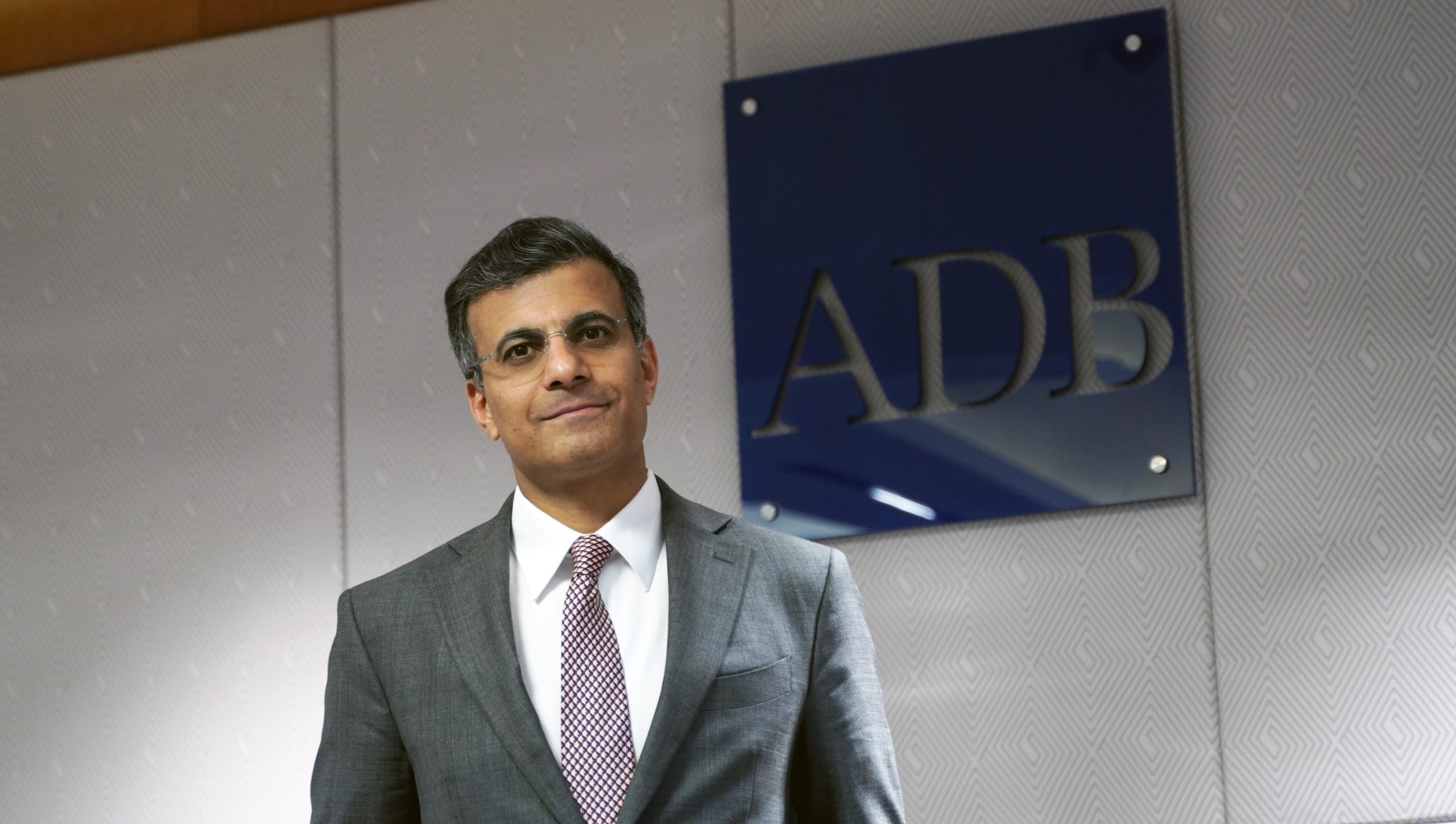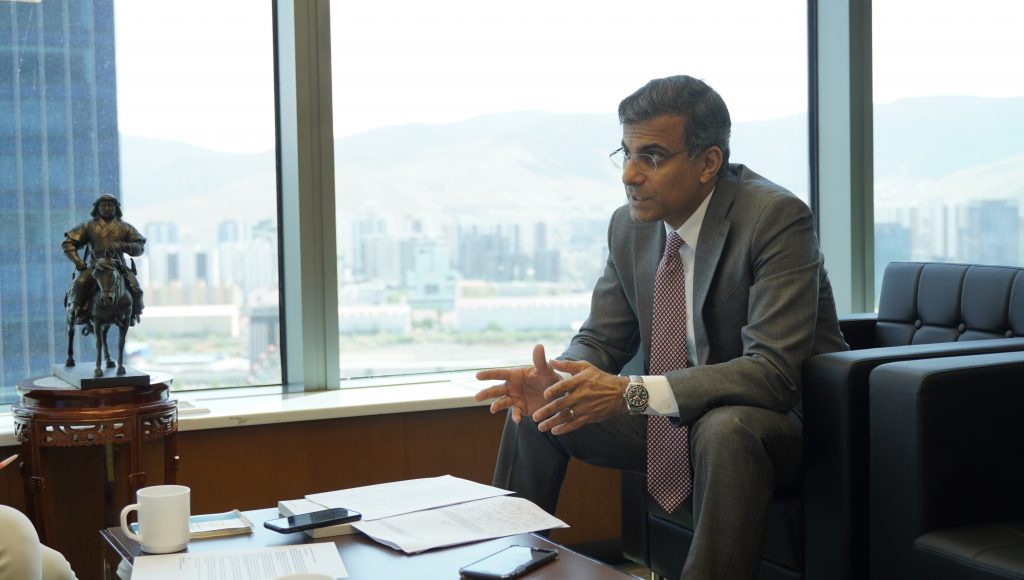Pavit Ramachandran: Building capacity for sustainable growth and green growth is supercritical for Mongolia

“Mongolian Economy” magazine spoke with Mr. Pavit Ramachandran, Asian Development Bank Country Director for Mongolia.
– This year marks the 31st anniversary of Mongolia and Asian Development Bank (ADB) partnership. As the largest multilateral development partner that has supported and cooperated with Mongolia`s social and economic development, what is your opinion on the current state of the investment climate in Mongolia?
– Mongolia is a peaceful and vibrant democracy. As a frontier market, Mongolia has resource abundance in the mining sector, and also has a lot of very important cultural and historical niches which are advantageous, and a lot of opportunities for investors. At present, the investment climate is quite challenging, exacerbated by the current economic situation because of the war in Ukraine and the COVID-related border restrictions in the south with the People’s Republic of China. However, I think these fundamental advantages still persist, and Mongolia is well positioned to capitalize on these advantages looking ahead, but there are a few important considerations to keep in mind.
First, Mongolia’s economic model is premised on exporting minerals, and importing almost all other goods; this means the government, in practice, imposes very few market access barriers. But it’s important to step back and look at the investment outlook from the standpoint of the overall macroeconomic picture. Mongolia has historically been susceptible to frequent booms and bust cycles triggered by FDI inflows being closely associated with commodity price fluctuations. The FDI inflows, as a result, have also been very volatile. Ensuring a stable macroeconomic environment with built on sound fiscal and debt parameters is essential to send the right signals to investors. Political stability, predictability, and strengthening the legal environment and regulations, as well as implementation and enforcement of laws are also crucial for Mongolia to really attract FDI in sectors, beyond mining. If you look globally and regionally, how countries attract FDI has almost become akin to an art form.
Strengthening transparency around capital investments and ensuring nondiscriminatory practices against foreign investors are factors that need to be addressed.
Mongolia imposes very few restrictions on capital inflows and does not restrict international payments and transfers. However, the capital market itself is quite underdeveloped here in Mongolia, with very little ability to trade in futures or derivatives. ADB helped the state-owned Mongolian Stock Exchange in the early days since the 1990s, through advisory support. This is the main venue for domestic capital and portfolio investments, but the banking system remains still quite concentrated, and most of the financing comes only through the banks, and very little goes through the capital markets outside. So, this presents another challenge, i.e., in terms of strengthening the financial sector.
Last point is corporate governance. If you see companies that have attracted investments, these are companies with strong track record of corporate governance, including companies where ADB has invested – both banks as well as private companies. Strengthening corporate governance is important and companies that are well managed, that are publicly listed on the Stock Exchange are likely to get more investments going forward.
– In the years since Mongolia became internationally open and transitioned to a market economy, it has attracted a significant amount of investment from more than 120 countries. However, no major development projects other than Oyu Tolgoi have been implemented during this period. What do you think are the main reasons why investors are so reluctant to invest in large projects?
– Economic diversification is important. But in Mongolia’s context, it does not mean totally neglecting the extractive sector or the mining sector, because the mining sector will continue to remain very important. Since 2011, when the large strategic mining deposits were really exploited, we have seen a lot of FDI flowing to the mining sector and this will likely increase now, once the Oyu Tolgoi’s underground mining starts its operations sometime next year – in the near term, the dependence on mining will not reduce, it’s actually going to increase. In this regard, I want to highlight two points.
First, is to focus on adding more value in the extractive sector. As we know, mining is a capital-intensive sector, it is not a job inclusive sector. It creates less jobs than other sectors such as services and agriculture. We need to strengthen the value linkages within the mining sector, which means focusing more on domestic processing. This will also need forging of stronger linkages between the foreign and domestic companies involved in the mining sector. In the non-mining sector, the real constraint is the ability to attract more FDI, particularly efficiency seeking FDI, this will need diversification and expansion of the export basket.
Focusing on the mid-stream and down-stream segments of the agriculture sector (meat, dairy and cashmere), in particular, will allow for more forward and backward linkages to be developed within the sector, and job creation.
Second, is the issue of macroeconomic stability. The growth forecast and prospects will depend on the government’s continued focus on fiscal consolidation to rein in public debt (particularly as the current crisis begins to abate) by strengthening domestic resource mobilization and through prudent public expenditure reforms. Mongolia’s medium-term growth prospects are positive, supported by growth in private consumption and continued steady investment in mining and manufacturing.

– Could you say more on the impact of policy stability, in terms of attract investment?
– Historically, one of the big things that investors look at is political stability and policy continuity. In the case of Mongolia, there has been a lot of volatility in terms of changes in government and associated political and bureaucratic transition. That has also unfortunately meant that there’s been a lot of changes and lack of predictability in policies, and ad hoc policy implementation and enforcement. So, I think what investors really want to see is keeping your promises. Saying that you will enforce your policies, you will implement your policies as designed and you will deliver the reforms that you set out to do right.
I believe, Mongolia now has a very good foundation, because this current government has been in power for four years. They have shown leadership by engaging with the private sector, and the business community; they have really also articulated the desire and the commitment to attract private investments. For example, on the New Economic Revival Policy, it is amply clear that many of these projects will need significant private investment to materialize; they cannot only be delivered through public sector, some of these planned infrastructure and ‘greenfield’ investments will also need to be delivered public private partnership arrangements.
There are a lot of things that Mongolia can already build on to attract FDI. There is renewed momentum with the creation of the new Ministry of Economic Development, including establishment of an agency within the Ministry focusing on FDI mobilization and retention.
There is also a new ministry for Digital Development and Communications, which is timely, given its mandate to leverage potential in Mongolia for digital technology investments and digital transformation across sectors, including in e-commerce, fintech, and banking sectors. Mongolia can also leverage or access other tools like business registration system, and aftercare services for investors to make it more appealing. These are things that have already been trialed at various levels and can be rolled out at a larger scale.
– The international economic crisis continues. Developing countries are implementing a number of policies to make their economies more resilient, with a focus on attracting foreign direct investment. Mongolia lags behind other countries in the region in this regard. How should we work in this time of pandemic to attract foreign investment? What are our strengths and weaknesses?
 – Unfortunately, Mongolia has been buffeted by twin external shocks – the war in Ukraine has affected trade and supply chains, and the persistent border restrictions since October last year with the People’s Republic of China has also directly impacted trade and revenues. Being a landlocked trade dependent economy, Mongolia has been particularly affected, and is trying to navigate as best as possible, through this crisis. Looking ahead, I think the first thing to say is Mongolia needs to optimize its macroeconomic and fiscal management. There is recent precedent for this; the period from 2017 to 2020 was a strong period in terms of how Mongolia managed its macroeconomic situation. They reduced their debt. They built up a small number of external buffers. They even ran a small fiscal surplus. So, I think the first thing is, as soon as this crisis starts to abate is that, Mongolia needs to embark on fiscal consolidation, they need to focus on more targeted social expenditures, gradually loosen the monetary policy, and that will automatically, I think, address some of the inflationary pressures, and inspire confidence and send the right signals to the market.
– Unfortunately, Mongolia has been buffeted by twin external shocks – the war in Ukraine has affected trade and supply chains, and the persistent border restrictions since October last year with the People’s Republic of China has also directly impacted trade and revenues. Being a landlocked trade dependent economy, Mongolia has been particularly affected, and is trying to navigate as best as possible, through this crisis. Looking ahead, I think the first thing to say is Mongolia needs to optimize its macroeconomic and fiscal management. There is recent precedent for this; the period from 2017 to 2020 was a strong period in terms of how Mongolia managed its macroeconomic situation. They reduced their debt. They built up a small number of external buffers. They even ran a small fiscal surplus. So, I think the first thing is, as soon as this crisis starts to abate is that, Mongolia needs to embark on fiscal consolidation, they need to focus on more targeted social expenditures, gradually loosen the monetary policy, and that will automatically, I think, address some of the inflationary pressures, and inspire confidence and send the right signals to the market.
The second issue is around economic competitiveness. The cost of reliable infrastructure provision, both ‘hard’ and ‘soft’ infrastructure, including trade facilitation systems and customs procedures, processes to reduce permissions, clearances required for business registration and trade, electric power supply and utility costs for companies is also a factor that businesses consider in weighing up their operating costs, and overall investment potential. ADB conducted a study which shows that 10% reduction of time involved in freight transport/clearances at the border would expand trade and raise the share of trade in Mongolia’s GDP by 0.65 percentage points. This shows that there are significant linkages between actually improving efficiency of border crossing points and their contribution to trade.
ADB has been involved in supporting the establishment of Customs Automated Information System (CAIS) to reduce the dependence of paperwork and improve efficiency of customs approvals. All of this has also an impact in improving overall foreign exchange inflows.
One area where ADB has been involved for a very long time is on regional cooperation on trade facilitation. We have a program called the Central Asia Regional Economic Cooperation Program (CAREC), and we found that by harmonizing customs procedures across both countries and on the border, and by aligning your health quarantine surveillance testing measures, there could be tangible improvements in trade flows. For example, in the Zamiin-Uud economic zone, we’re trying to do is set up a single window trading system that should reduce the need for paperwork, additional permissions, and clearances. We are also looking at a number of priority border crossing points for investment in the future, to upgrade their operations, which in turn, should invigorate trade and investment.
– In which areas does the Asian Development Bank conclude that Mongolia should attract foreign investment as a priority? Are there any studies and recommendations in this regard?
– Let me highlight four areas. First on, agriculture and food production. Although, Mongolia is ranked among top 15 in Asia in terms of food self-sufficiency index, this mask a number of untapped opportunities. Meat self-sufficiency is very high, but Mongolia imports more than 45% of its vegetables. There is also significant potential around meat processing given its linkages to upstream and downstream segments of the value chain – of the roughly 550,000 tons of meat produced in Mongolia, only about 5% are produced at processing factories. So, meat, cashmere, dairy are important sectors.
The second area relates to green investment. The President of Mongolia has announced, and Mongolia has committed to the one billion tree initiative, Mongolia represented by President Khurelsukh, demonstrated leadership in the last Climate Summit. This provides an opportunity to invest not just in tree planting, but also in sustainable forestry and land (and water resource management), involving the private sector and local communities. There is already a lot of momentum around green financing, with the development of a taxonomy for green finance already approved by the Financial Stability Commission, and the Mongolia Green Finance Corporation already operational, within climate fund secured from the Green Climate Fund.
ADB is very active in the area of mobilizing and developing green investments – we are, for example, working on a number of projects to accelerate the transition and facilitate the uptake of renewable energy. The current focus is on adding storage to enable greater renewable contributions.
A battery energy storage project is currently under implementation, and we have a pumped storage hydropower project in our pipeline for 2025. The battery project will maximize contributions of existing renewable generators, currently curtailed. The storage hydro could enable the addition of 1.3 GW of new renewable generation as lower-cost solution than coal. Currently, we are also in the final stages of development of a large program on aimag and soums development focused on rangeland and pastureland management countrywide involving the Green Climate Fund and the European Union. In short, there’s a lot of potential to attracts green finance, through concessional funding, but also commercial investors and institutional investors (for example, pension funds, insurance companies) for projects that are commercially viable and have social and environmental returns.
The third area I will touch on is tourism, particularly in eco-tourism, and adventure tourism, in other words, niche tourism. The focus has not been high-volume tourism because Mongolia will never be able to compete on numbers, but within specific market segments, Mongolia can really attract premium tourists, and this presents a real opportunity.
As part of our focus on supporting the tourism sector ADB has adopted a medium-term programmatic approach around supporting community-based and nature-based tourism development in Western and Eastern Mongolia.
The last one is ecommerce, and I think there’s a lot of potential to do more on ecommerce because Mongolia has the basic ingredients – a high smartphone penetration rate, and an advanced fintech and mobile payment system. More than 60% of the population regularly use the internet and the use of mobile phones is at even higher level. But, less than 25% of the population actually use ecommerce for purchases, significantly less than other countries in the region. This is another area that represents growth potential, and the potential to attract foreign investment.